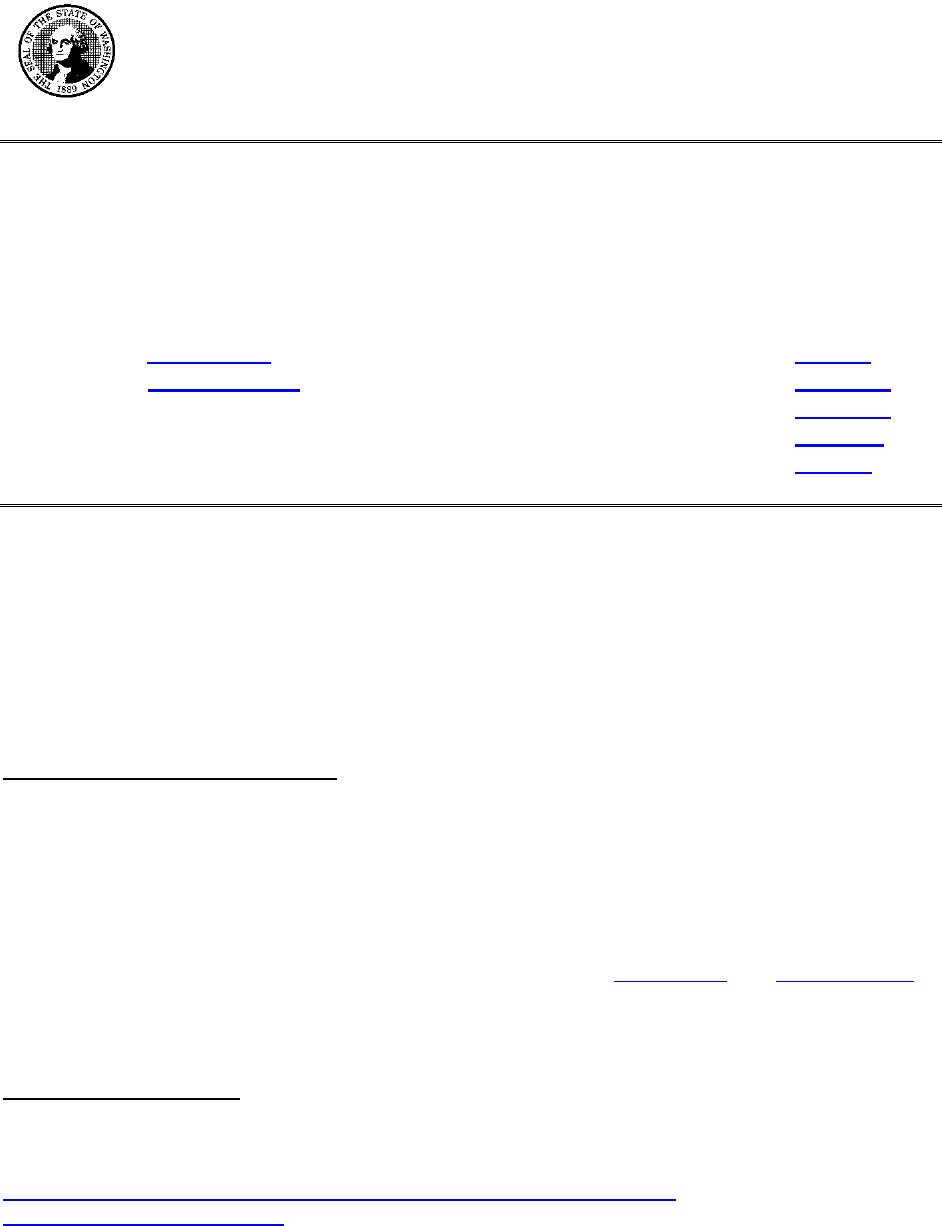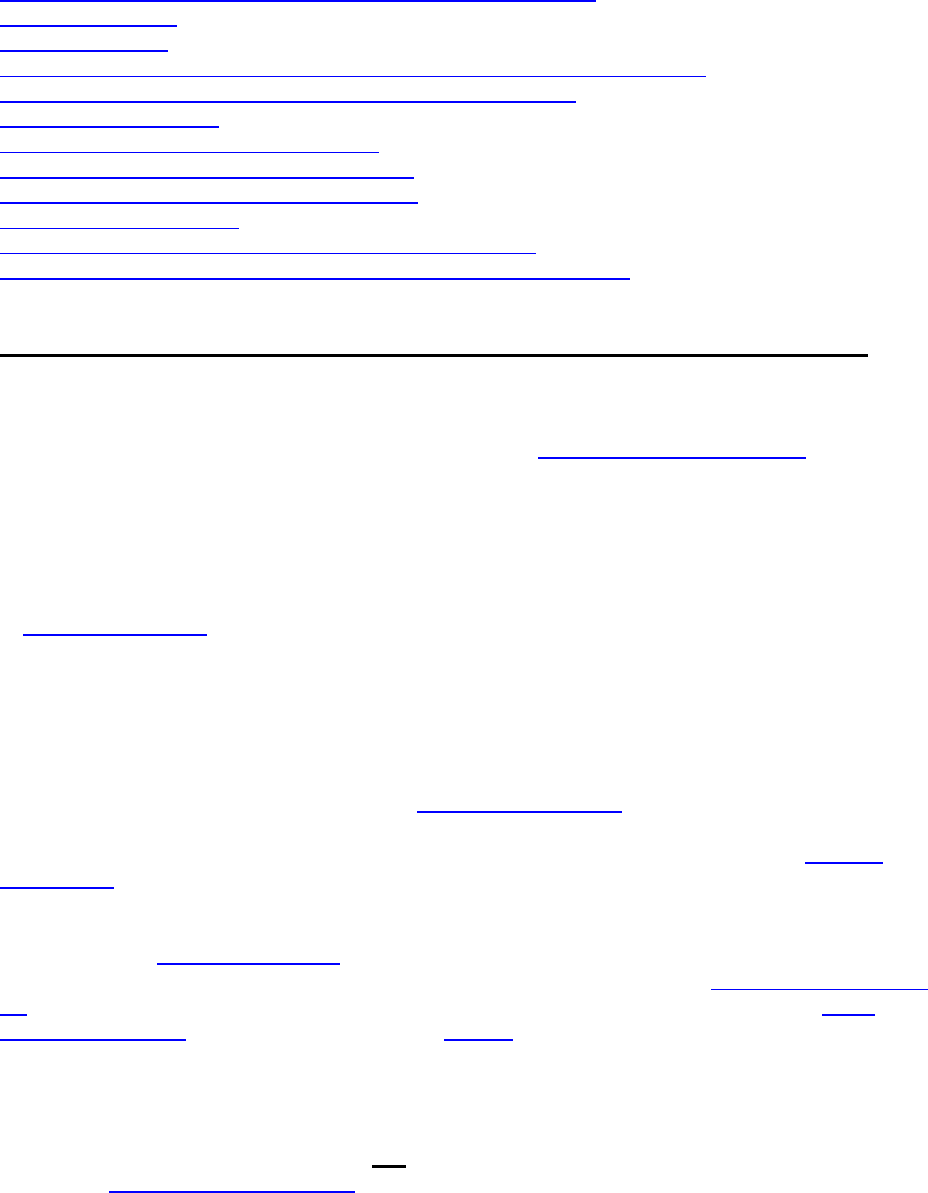
ES.B.1 Paid Sick Leave – FAQs Page 1 of 22 12/7/2021
ADMINISTRATIVE POLICY
STATE OF WASHINGTON
DEPARTMENT OF LABOR AND INDUSTRIES
EMPLOYMENT STANDARDS
TITLE: PAID SICK LEAVE – FREQUENTLY NUMBER: ES.B.1
ASKED QUESTIONS
ISSUED: 6/5/2020
REVISED: 12/7/2021
CHAPTER: RCW 49.46 SEE ALSO: ES.A.1,
WAC 296-128 ES.A.9.1—
ES.A.9.8,
ES.A.13,
ES.C.2.
ADMINISTRATIVE POLICY DISCLAIMER
This policy is designed to provide general information in regard to the current opinions of the Department of Labor and Industries on
the subject matter covered. This policy is intended as a guide in the interpretation and application of the relevant statutes,
regulations, and policies, and may not be applicable to all situations. This policy does not replace applicable RCW or WAC
standards. If additional clarification is required, the Program Manager for Employment Standards should be consulted.
This document is effective as of the date of print and supersedes all previous interpretations and guidelines. Changes may occur
after the date of print due to subsequent legislation, administrative rule, or judicial proceedings. The user is encouraged to notify the
Program Manager for Employment Standards to provide or receive updated information. This document will remain in effect until
rescinded, modified, or withdrawn by the Director of the Department of Labor and Industries or their designee.
PURPOSE OF THIS DOCUMENT
The purpose of this administrative policy is to answer frequently asked questions regarding
Washington’s paid sick leave requirements. For more information on the sources referenced in
this policy, please click on the hyperlinks provided.
Employers who intend to use other forms of leave programs to meet the state’s paid sick leave
requirements—for example, paid time off (PTO)—must ensure that such leave programs at
least meet or exceed all of the minimum requirements listed in RCW 49.46 and WAC 296-128.
For additional clarification, please contact the Employment Standards Program at the
Department of Labor & Industries at 1-866-219-7321.
TABLE OF CONTENTS
Please Ctrl + Click on the applicable section to jump to that topic.
Section 1: Employee Entitlement and General Compliance Questions
Section 2: Records Required

ES.B.1 Paid Sick Leave – FAQs Page 2 of 22 12/7/2021
Section 3: Employer Notification and Reporting to Employees
Section 4: Accrual
Section 5: Usage
Section 6: Reasonable Notice for an Employee’s Use of Paid Sick Leave
Section 7: Verification for Absences Exceeding Three Days
Section 8: Rate of Pay
Section 9: Payment of Paid Sick Leave
Section 10: Separation and Reinstatement
Section 11: Paid Time Off (PTO) Programs
Section 12: Frontloading
Section 13: Absences Not Covered by Paid Sick Leave
Section 14: Interaction with Other State and Federal Leave Laws
SECTION 1. EMPLOYEE ENTITLEMENT AND GENERAL COMPLIANCE QUESTIONS
A. When did the state’s paid sick leave requirements take effect?
On November 8, 2016, voters in Washington approved Initiative Measure No. 1433 (I-1433). I-
1433, in part, requires employers to provide their employees with paid sick leave. The state’s
paid sick leave requirements went into effect on January 1, 2018.
B. Are all employers required to provide paid sick leave?
All employers doing business in Washington with workers that meet the definition of “employee”
in RCW 49.46.010(3) are required to provide paid sick leave to such employees, regardless of
the employer’s business size. Please see Section 1.C and Section 1.D for more information.
C. Are all workers in Washington entitled to receive paid sick leave from their employer?
Most workers in Washington are entitled to the state’s paid sick leave protections, although
some workers may be exempt based on their job duties and requirements. The language of the
state’s paid sick leave law was written into Chapter 49.46 RCW – the Minimum Wage Act
(MWA). The MWA addresses numerous employer requirements and employee rights, including
the state minimum wage, overtime, tips, service charges, and paid sick leave. See Chapter
49.46 RCW.
The pre-existing definition of “employee” in the MWA applies to the paid sick leave law
provisions. See RCW 49.46.010(3). Workers who do not meet the definition of “employee” are
not entitled to the protections of the MWA, including paid sick leave. See RCW 49.46.010(3)(a)-
(p). For more information about workers who are exempt from the MWA, please see RCW
49.46.010(3)(a)-(p) and Administrative Policy ES.A.1. Application of these exemptions is fact-
specific and must be carefully analyzed on a case-by-case basis. Please note that a worker’s
status as full-time, part-time, temporary, or seasonal is not a relevant factor in determining a
worker’s exempt status.
D. Are there other workers who are not entitled to paid sick leave, other than those
exempt at RCW 49.46.010(3)(a)-(p)?
Yes, workers who are bona fide employees of the federal government, certain federal
contractors, workers of federally-recognized sovereign tribes performing work on tribal lands,

ES.B.1 Paid Sick Leave – FAQs Page 3 of 22 12/7/2021
and bona fide independent contractors are generally not entitled to the state’s paid sick leave
protections. Whether a worker is a bona fide independent contractor for purposes of the MWA
depends on the economic realities of the employment relationship. Those with questions about
federal contractors, federal employees, and federally-recognized sovereign tribes are
encouraged to contact the U.S. Department of Labor, Wage and Hour Division.
E. What if an employee works in Washington and one or more other states, or works out
of state for a Washington employer?
The MWA regulates employers who are doing business in Washington and employers who have
hired Washington-based employees. An employee who works in Washington and one or more
other states, or works out of state for a Washington employer, may be entitled to the state’s paid
sick leave protections if the employee is considered a “Washington-based” employee. For more
information about the Washington-based standard, see Administrative Policy ES.A.13.
F. Are all workers who are exempt from the state’s overtime requirements exempt from
paid sick leave?
No, only certain workers are exempt from all the requirements of the Minimum Wage Act.
Workers who do not meet the definition of “employee” are not entitled to the protections of the
MWA, including paid sick leave. See RCW 49.46.010(3)(a)-(p). Other workers may be exempt
from the state’s overtime requirements, but still be entitled to paid sick leave. See RCW
49.46.130. See also Administrative Policy ES.A.8.1 for more information on overtime pay
requirements. For a worker to be exempt from the paid sick leave law, the worker would need to
meet one of the exemptions provided in RCW 49.46.010(3), or be one of the workers listed in
Section 1.D of this policy.
G. Are workers who are paid on a salary basis exempt from paid sick leave?
No, not all salaried workers are exempt. Only certain workers who are paid on a salary basis
may be exempt depending on their compensation and job duties. See RCW 49.46.010(3)(c) and
WAC 296-128-500 through -540. These exemptions apply to workers employed in a bona fide
executive, administrative, or professional (“EAP”) capacity. For more information about the EAP
exemptions, please see Administrative Policies ES.A.9.1 through ES.A.9.8.
H. Can a collective bargaining agreement waive the state’s paid sick leave requirements?
No, any agreement between an employee and an employer which provides an employee less
than what is due under the Minimum Wage Act is unlawful. See RCW 49.46.090. This limitation
applies to collective bargaining agreements (CBA) that provide employees less than what they
are due under the state’s paid sick leave requirements. See RCW 49.46.090(1).
I. May an employer “cash out” an employee’s accrued, unused paid sick leave during
ongoing employment?
Employers may not routinely cash out an employee’s accrued, unused paid sick leave during
ongoing employment. The intent of the voter-passed paid sick leave law is for “employers to
provide employees with paid sick leave to care for the health of themselves and their families.”
See RCW 49.46.005. An employer may not cash out an employee’s accrued, unused paid sick
leave because that would provide the employee with less than what the employee is due under
RCW 49.46. See RCW 49.46.090. However, an employer may cash out an employee’s accrued,

ES.B.1 Paid Sick Leave – FAQs Page 4 of 22 12/7/2021
unused paid sick leave at the end of the “year” (as defined at WAC 296-128-620(6)) for
balances in excess of the 40-hour carryover requirement at RCW 49.46.210(1)(j). An employer
may also choose to cash out accrued paid sick leave at separation from employment, but the
employer is generally not required to do so. See RCW 49.46.210(1)(k) and WAC 296-128-
690(1).
Some construction workers may be subject to a CBA that provides payment for paid sick leave
accruals prior to employee use. These alternative payment structures are not considered a cash
out and leave paid in such methods must still retain all the protections of RCW 49.46.200
through 49.46.830, and all applicable paid sick leave rules. See Section 1.L in this policy for
more information.”
J. May an employer offer a paid sick leave program that exceeds the requirements of the
law?
Yes, employers may provide more generous paid sick leave policies or permit the use of paid
sick leave for additional purposes. See RCW 49.46.210(1)(e).
K. Are employers who provide a more generous paid sick leave program required to
follow the state’s paid sick leave standards?
Employers may provide a more generous paid sick leave program than that required by the
MWA. If an employer does not delineate which hours are protected under the MWA, and which
are not, the department will apply the protections of the paid sick leave law to all accrued leave
hours in that bank of leave.
Example: An employer has chosen to provide paid sick leave to employees at a rate of
one hour of paid sick leave accrued for every 25 hours worked. The employer does not
differentiate between the leave provided to meet the state’s minimum paid sick leave
requirements and the additional leave accrued under their more generous policy. As an
employee would not be able to differentiate between state-required leave and the more
generous leave provided by their employer, all accrued leave hours in that bank of leave
are protected under law.
An employer may apply their own standards to any leave that is more generous than the state-
required leave, but only if the employer tracks the leave separately and shows their employees
what leave they have accrued under the state law and what leave is more generous and not
subject to state laws.
Example: An employer has chosen to provide additional paid sick leave to their
employees beyond what is required under state law. The employer maintains a paid sick
leave program that is compliant with all applicable state laws and that accrues at a rate
of one hour of paid sick leave for every 40 hours worked. The employer also maintains a
separate bank of paid sick leave that provides one additional day of paid sick leave to
employees at the start of every month. As long as employees can clearly differentiate
between the two paid sick leave banks, the separate bank of paid sick leave that
provides one additional day of paid sick leave is not subject to the paid sick leave laws.
L. How do the paid sick leave requirements for the construction trades differ?

ES.B.1 Paid Sick Leave – FAQs Page 5 of 22 12/7/2021
RCW 49.46.180 allows for construction workers to receive payment for sick leave prior to the
workers’ use of the accrued leave, but the banked leave must remain available for protected use
after payment. For this practice to be allowable, the parties must agree to this practice in a
collective bargaining agreement and the union signatory to the collective bargaining agreement
must be an approved referral union program under RCW 50.20.010 and WAC 192-210-110.
The agreement must still meet the other requirements of RCW 49.46.200 through 49.46.830,
and all applicable paid sick leave rules.
SECTION 2. RECORDS REQUIRED
A. What records must employers keep related to paid sick leave?
Employers must keep records of employees’:
Paid sick leave accruals each month;
Any unused paid sick leave available for use;
Date of commencement of employment;
Paid sick leave reductions each month, which includes but is not limited to: paid sick
leave used, paid sick leave donated to a co-worker through a shared leave program,
and paid sick leave not carried over at the end of the “year” (as defined in WAC 296-
128-620(6)). See WAC 296-128-010(12)-(14).
B. How long must employers retain paid sick leave records?
Employers must retain such records for at least three years. See WAC 296-128-020. If an
employer willfully fails to maintain paid sick leave records, the department may issue a civil
penalty to that employer. See WAC 296-128-830(3).
C. What records must be reported to the Department of Labor & Industries regarding an
employer’s paid sick leave program or policy?
Employers do not need to provide paid sick leave records to the department unless the
department requests them as part of an investigation or audit.
D. Are employers required to report paid sick leave hours for Industrial Insurance
(Workers’ Compensation) purposes?
No, employers need only report and pay premiums on actual hours worked. See WAC 296-17-
31021.
SECTION 3. EMPLOYER NOTIFICATION AND REPORTING TO EMPLOYEES
A. What are the notification requirements for employers reporting paid sick leave to their
employees?
Employers are required to provide two specific notifications for reporting paid sick leave to their
employees. See WAC 296-128-760. The notification requirements are:

ES.B.1 Paid Sick Leave – FAQs Page 6 of 22 12/7/2021
1. Employers must provide a one-time notification to an employee of their right to paid
sick leave. This notification must be in a written or electronic form, and be provided to
employees on the date of their commencement of employment. For employees hired
prior to January 1, 2018, employers should have provided this notification no later than
March 1, 2018. See WAC 296-128-760(1). This one-time notification must provide the
following information:
A. An employee’s entitlement to paid sick leave;
B. The rate at which an employee will accrue paid sick leave;
C. The authorized purposes that an employee may use their accrued paid sick
leave for (listed at RCW 49.46.210(1)(b) and (c)); and
D. That retaliation by the employer for the employee’s lawful use of paid sick
leave and all rights under Chapter 49.46 RCW is prohibited.
Note: The department has developed a model one-time notification form. It is
available on the department’s website at the following link:
https://lni.wa.gov/workers-rights/leave/paid-sick-leave/implementing-a-paid-sick-
leave-policy
2. Employers must provide ongoing notification, not less than monthly, detailing to
each employee how much paid sick leave the employee has accrued and has used
since the last notification was provided, any other reductions in the paid sick leave
balance since the last notification, and any available paid sick leave for use. This
notification must be provided either in a written or electronic form. See RCW
49.46.210(1)(i) and WAC 296-128-760(2).
Note: Employers may satisfy this requirement by providing such notification on a
pay statement or pay stub, as long as the notification includes the information
listed immediately above. See RCW 49.46.210(1)(i) and WAC 296-128-760(2).
B. Are the notification requirements different for employers who frontload paid sick
leave?
Yes. Please see Section 12.G of this policy for more information.
C. Are there any other paid sick leave notification requirements other than those listed at
Section 3.A and 3.B?
Yes, in addition to the notification requirements listed at Section 3.A and Section 3.B,
employers must post in the workplace the “Your Rights as A Worker” poster issued by the
department. This poster needs to be displayed at each of the employer’s business locations, in
areas that are easily accessible to all employees.
To request a “Your Rights as a Worker” poster, please contact the department, or visit the
department’s Forms and Publications page by accessing the following link:
https://lni.wa.gov/forms-publications/search.

ES.B.1 Paid Sick Leave – FAQs Page 7 of 22 12/7/2021
SECTION 4. ACCRUAL
A. What is the required rate that employees must accrue paid sick leave?
Employees must accrue at least one hour of paid sick leave for every 40 hours worked, for all
“hours worked.” See RCW 49.46.210(1)(a) and WAC 296-128-620(1).
B. What is the definition of “hours worked”?
Hours worked is defined as “all hours during which the employee is authorized or required by
the employer to be on duty on the employer's premises or at a prescribed work place.” See
WAC 296-126-002(8); WAC 296-128-600(9). This includes hours worked that are overtime
hours. For more information about hours worked, see Administrative Policy ES.C.2.
C. Is there a cap on the amount of paid sick leave hours an employee may accrue?
No, there is no cap on the amount of paid sick leave hours an employee may accrue.
Employees must accrue paid sick leave for all “hours worked.” See RCW 49.46.210(1)(a) and
WAC 296-128-620(1).
D. Is paid sick leave accrual dependent on the period in which hours are worked?
No, paid sick leave accrues continuously based on all “hours worked.” There is no set time-
frame (for example: daily, weekly, monthly, etc.) for which “hours worked” need to be performed
for an employee to accrue paid sick leave. Once an employee has reached the 40
th
hour of work
performed, the employee must accrue at least one hour of paid sick leave. See RCW
49.46.210(1)(a) and WAC 296-128-620(1).
E. Do employees accrue paid sick leave for hours when they are not performing work or
while using leave?
No, employees are only entitled to accrue paid sick leave for “hours worked.” Employers are not
required to allow employees to accrue paid sick leave for hours paid when not working, but may
choose to do so as part of a more generous leave policy. See WAC 296-128-620(3).
Example: Employers are not required to allow employees to accrue paid sick leave
during vacation, paid time off (PTO), or while using paid sick leave.
F. May employers define “year” for accrual and carryover purposes?
Yes, an employer may define “year” for paid sick leave accrual and carryover purposes. The
default definition of “year” is calendar year, unless the employer provides a different definition in
an employer policy or a collective bargaining agreement.
A year may be defined by an employer as a “calendar year, fiscal year, benefit year,
employment year, or any other fixed consecutive twelve-month period established by an
employer policy or a CBA, and used in the ordinary course of the employer's business for the
purpose of calculating wages and benefits.” WAC 296-128-620(6).
G. If an employee has accrued, unused paid sick leave at the end of the year, how much
paid sick leave may the employee carry over into the following year?

ES.B.1 Paid Sick Leave – FAQs Page 8 of 22 12/7/2021
If an employee has accrued, unused paid sick leave at the end of the year, paid sick leave
balances of 40 hours or less must carry over to the following year. See RCW 49.46.210(1)(j)
and WAC 296-128-620(4) and (5). Employers may allow for more generous carryover.
The department recommends that employers notify their employees that carryover is limited to
40 hours per year unless the employer chooses to allow for more generous carryover.
Note: WAC 296-128-760(2) requires an employer to document all reductions of paid sick
leave balances as part of the ongoing notification requirement. See Section 3.A.2. If an
employer reduces hours in an employee’s sick leave bank because of the employer’s
carry over practice, the employer must track the reduction and notify the employee.
Example: An employee accrues and does not use 52 hours of paid sick leave in 2018.
The employer caps the employee’s carryover of accrued, unused paid sick leave at 40
hours. The employee begins 2019 with 40 hours of paid sick leave. During 2019, the
employee accrues 52 hours of paid sick leave in addition to the unused, accrued paid
sick leave carried over from 2018. If the employee does not use any paid sick leave in
2019, the employee would have a balance of paid sick leave of 92 hours at the end of
2019. The employer can choose to cap the employee’s carryover of accrued, unused
paid sick leave at 40 hours into the following year. If the employer chose to cap the
employee’s carryover in this example, the employee would forfeit 52 hours of unused
paid sick leave and would begin 2020 with 40 hours of paid sick leave in the employee’s
leave bank.
H. Do employees continue to accrue paid sick leave if they carry over accrued, unused
paid sick leave from the prior year?
Yes, the accrual of paid sick leave in the following year is in addition to the carried-over paid
sick leave hours from the previous year. See WAC 296-128-620(4).
Example: An employee carries over 40 hours of accrued, unused paid sick leave into
2019 from 2018. During the first week of 2019, the employee works 40 hours and
accrues one hour of paid sick leave. The one hour of paid sick leave is in addition to the
40 hours of accrued, unused paid sick leave carried over from 2018. This means that the
employee would have a balance of 41 hours of paid sick leave. The one additional hour
of accrued paid sick leave needs to be made available for use in a manner consistent
with the employer's established payment interval or leave records management system,
but no later than one month after accrual. See WAC 296-128-630(3).
SECTION 5. USAGE
A. When is an employee entitled to use accrued paid sick leave for the authorized
purposes listed at RCW 49.46.210(1)(b) and (c)?
An employee is entitled to use accrued paid sick leave for any of the authorized purposes listed
at RCW 49.46.210(1)(b) and (c) beginning on the 90
th
calendar day after the “commencement of
his or her employment.” See RCW 49.46.210(1)(d) and WAC 296-128-630(2) and (3).
“Commencement of his or her employment” is defined as “no later than the beginning of the first

ES.B.1 Paid Sick Leave – FAQs Page 9 of 22 12/7/2021
day on which the employee is authorized or required by the employer to be on duty on the
employer's premises or at a prescribed workplace.” WAC 296-128-600(2).
B. Once an employee is eligible to use accrued paid sick leave, when does an employer
need to make paid sick leave accruals available to employees for use during ongoing
employment?
Employers must make paid sick leave accruals available to employees for use in a manner
consistent with the employer’s established payment intervals or leave records management
system, but may not exceed one month after the date of accrual. WAC 296-128-630(3).
C. Are employees entitled to use paid sick leave during time periods when the employee
is not required to work?
No, an employee must be required to work to be entitled to the use of their accrued, unused
paid sick leave. An employee is “required to work” when there is a reasonable expectation of
attendance for a work shift.
Example 1: A worker’s regularly scheduled shifts are Monday through Friday, 8:00 a.m.
to 5:00 p.m. This worker never performs work outside of the regularly scheduled shift.
Such worker is not required to work on weekends, and would not be entitled to the use
of paid sick leave on weekends.
Example 2: A school district has a list of 10 substitute teachers to call every time a
teacher becomes ill. Such substitutes are free to decline an offer to substitute when
called without repercussion, and the employer is free to move down the list and call
other available substitutes to fill an absent teacher’s shift. If a substitute declines the
assignment when first called, then such substitute is not “required” to work, as the
substitute has not created a reasonable expectation of attendance. If, however, the
substitute accepts the position (for whatever term of time), creating a reasonable
expectation of attendance, then the substitute would be “required” to work and is
therefore entitled to the use of accrued, unused paid sick leave should the need for the
use of paid sick leave later arise after the substitute accepts the teaching assignment.
D. Can employers require an employee to use their accrued paid sick leave, or deduct
paid sick leave from an employee’s balance, without the employee’s authorization?
No, it is the employee’s right to choose to use accrued, unused paid sick leave for the purposes
authorized at RCW 49.46.210(1)(b) and (c). An employer may not require an employee to use
accrued, unused paid sick leave. If an employee takes time off for what would otherwise be an
authorized purpose under the paid sick leave law, but does not choose to use their accrued,
unused paid sick leave for such time, the employer cannot require the use of the employee’s
accrued, unused paid sick leave to cover this absence. In such a circumstance, the employee’s
absence is not subject to the protections of the MWA (Chapter 49.46 RCW), and the employee
could be subject to discipline for the absence.
E. How does an employer know if an employee intends on using paid sick leave?
Employers should provide employees with policies or other guidelines that outline expectations
for reporting when an employee intends to use paid sick leave and administer these policies
consistently. If there is any ambiguity as to whether an employee intends to use paid sick leave,

ES.B.1 Paid Sick Leave – FAQs Page 10 of 22 12/7/2021
the department recommends that employers obtain a confirmation from the employee that they
wanted to use paid sick leave hours to cover the absence. For example, if an employee leaves
a message or text that does not clearly request paid sick leave, an employer may subsequently
ask that the employee confirm the request for paid sick leave with a clearer statement from the
employee that the employee was requesting paid sick leave.
Employers may implement a reasonable notice policy that requires employees to provide
notification in a timely manner when electing to use accrued paid sick leave to cover for an
absence. For more information about reasonable notice for an employee’s use of paid sick
leave, see SECTION 6 of this policy.
F. May an employer adopt an incentive-based program that rewards employees for not
using their accrued paid sick leave?
No, an incentive-based program that counts the lawful use of paid sick leave as a factor in
determining an employee’s entitlement to an additional benefit is considered a form of retaliation
for an employee’s lawful use of paid sick leave. The lawful use of paid sick leave means that an
employee has accrued, unused paid sick leave and is using it for one of the authorized
purposes at RCW 49.46.210(1)(b) and (c). For example, programs that count the lawful use of
paid sick leave as a disqualifying factor from a bonus or reward would unlawfully restrain an
employee’s right to use accrued paid sick leave. See WAC 296-128-770(1).
Note: WAC 296-128-770(1) does not prevent employers from adopting a policy
or CBA provision that allows employees to cash-out any remaining leave above
the 40-hour carryover requirement at the end of the year or upon separation, or
converting remaining leave above the 40-hour carryover requirement into other
benefits, such as vacation or PTO.
G. What are the authorized purposes for which an employee may use accrued paid sick
leave?
An employee may use accrued, unused paid sick leave for the following authorized purposes
listed at RCW 49.46.210(1)(b) and (c):
1. To care for themselves or a “family member” for the following reasons: mental or
physical illness, injury, or health condition; to accommodate the employee’s/family
members’ need for medical diagnosis, care, or treatment of a mental or physical illness,
injury, or health condition; or, for an employee’s/family member’s need for preventative
medical care.
2. When an employee’s place of business, or the employee’s child’s school or
place of care has been closed by order of a public official for any health-related
reason.
Note: A closure due to weather conditions is not an authorized purpose for the
use of paid sick leave, unless the employer allows for it.
3. When an employee qualifies for leave under Chapter 49.76 RCW – the Domestic
Violence Leave Act. For more information on the Domestic Violence Leave Act, please
see the following webpage: https://lni.wa.gov/workers-rights/leave/domestic-violence-
leave

ES.B.1 Paid Sick Leave – FAQs Page 11 of 22 12/7/2021
H. What is the definition of a “family member”?
Family member (RCW 49.46.210(2)) is defined as:
1. A child including: a biological, adopted, or foster child, stepchild, or a child to whom
the employee stands in loco parentis, is a legal guardian, or is a de facto parent,
regardless of age or dependency status;
2. A parent including: a biological, adoptive, de facto, or foster parent, stepparent, or
legal guardian of an employee or the employee's spouse or registered domestic partner,
or a person who stood in loco parentis when the employee was a minor child;
3. A spouse;
4. A registered domestic partner;
5. A grandparent;
6. A grandchild; or
7. A sibling.
Employers may choose to allow employees to use paid sick leave for more generous purposes
than required by law, including through a more generous interpretation of “family member.”
Note: RCW 49.46.210(2) covers family members regardless of age.
I. Is there a cap on the amount of accrued paid sick leave hours an employee may use?
No, there is no cap on the amount of accrued, unused paid sick leave hours an employee may
use. If an employee has accrued, unused paid sick leave, and needs to use such paid sick
leave for one of the authorized purposes listed at RCW 49.46.210(1)(b) and (c), then the
employee must be allowed to do so. See WAC 296-128-630(1). Please note that an employer
may not seek verification that an employee’s use of paid sick leave is for an authorized purpose
under RCW 49.46.210(1)(b) and (c) until the employee has an absence that exceeds three
days. See WAC 296-128-600(1) and Section 7 of this policy, below, for more information.
J. In what increments may employees use accrued paid sick leave?
Employers must allow employees to use paid sick leave in increments consistent with the
employer’s established payment interval or leave records management system, but not to
exceed one hour. See WAC 296-128-630(4).
Example: If an employer’s normal practice is to track increments of work for the
purposes of compensation in 15-minute increments, then an employer must allow
employees to use paid sick leave in 15-minute increments.
Note: Employers may request a variance from the required increments of use, if an employer
can establish “good cause.” A showing of good cause requires the employer to show that
compliance with the required increments of use is infeasible, and that the requested variance

ES.B.1 Paid Sick Leave – FAQs Page 12 of 22 12/7/2021
will not have a significant harmful effect on the health, safety, and welfare of the involved
employees. For more information about variances, see WAC 296-128-640. An employer may
apply for a variance by following the instructions on the variance application form:
https://lni.wa.gov/forms-publications/F700-196-000.pdf.
SECTION 6. REASONABLE NOTICE FOR AN EMPLOYEE’S USE OF PAID SICK LEAVE
A. May an employer require employees to give reasonable notice of their intent to use
paid sick leave?
Yes, so long as such notice does not interfere with an employee’s lawful use of paid sick leave.
See RCW 49.46.210(1)(f). If an employer requires its employees to provide reasonable notice
for the use of paid sick leave, the employer must have a written policy or a collective bargaining
agreement in place which outlines the requirements the employee must meet to give such
notice. See WAC 296-128-650(3).
The department has developed a model reasonable notice policy and forms for employer use,
which are available on the department’s website at the following link: https://lni.wa.gov/workers-
rights/leave/paid-sick-leave/implementing-a-paid-sick-leave-policy
B. What reasonable notice parameters may an employer set through its policy?
If an employer requires their employees to give reasonable notice of an absence from work for
an authorized purpose under RCW 49.46.210(1)(b), the employer must follow all of the following
requirements:
1. If the need for paid sick leave is foreseeable, the employer may require advance notice
from the employee. Unless the employer allows less advance notice, the employee must
provide notice at least 10 days, or as early as practicable, in advance of the use of paid
sick leave. See WAC 296-128-650(1)(a).
“Foreseeable” means situations where the employees know that they will use paid sick
leave for an authorized purpose at least 10 days before the use arises. Examples
include scheduled medical appointments and pre-planned surgeries.
2. If the need for paid sick leave is unforeseeable, the employer may also choose to
require notice from the employee. If the employer chooses to require notice, it may
require the employee to provide notice to the employer as soon as possible before the
required start of their shift, unless it is not practicable to do so. In the event it is
impracticable for an employee to provide notice to their employer, another person may
provide notice to the employer on the employee's behalf. See WAC 296-128-650(1)(b).
“Unforeseeable” means situations where the employee does not know, at least 10 days
in advance, that the need to use paid sick leave will arise. Examples include, but are not
limited to: when an employee becomes ill while at work; when an employee becomes ill
an hour before the required start of their shift; or when an employee’s child becomes ill
at school and the employee uses their paid sick to leave work to care for the sick child.
If an employer requires employees to give reasonable notice of an absence from work for the
use of paid sick leave for an authorized purpose under the Domestic Violence Leave Act (RCW

ES.B.1 Paid Sick Leave – FAQs Page 13 of 22 12/7/2021
49.46.210(1)(c) and Chapter 49.76 RCW), any such reasonable notice requirements must
comply with the provisions outlined in WAC 296-135-060. See WAC 296-128-650(2).
C. What if an employer has a lawful reasonable notice policy and the employee does not
follow it?
If an employee fails to provide notice as required by the employer’s lawful reasonable notice
policy, and the employee later requests use of paid sick leave for an authorized purpose to
cover such absence, the employee may be subject to discipline for not providing reasonable
notice. However, in this circumstance, the employer may not deny the use of the paid sick leave
if it is for an authorized purpose. Please see Section 5 for more information on an employee’s
right to use their accrued, unused paid sick leave.
SECTION 7. VERIFICATION
A. May an employer request verification for an employee’s use of paid sick leave?
Yes, an employer may request verification if an employee’s absence exceeds three days. This
means “absences exceeding three consecutive days an employee is required to work.” See
WAC 296-128-600. If an employer requires verification, verification must be provided to the
employer within a reasonable time period during or after the absence. An employer's
requirements for verification may not result in an unreasonable burden or expense on the
employee, and may not exceed privacy or verification requirements otherwise established by
law. See RCW 49.46.210(1)(g) and WAC 296-128-660.
If an employer requires verification for the use of paid sick leave under RCW 49.46.210(1)(b)
and (c), the employer must have a written policy or a collective bargaining agreement outlining
any such requirements. The employer must notify the employee of such policy or agreement,
including the employee's right to assert that the verification requirement results in an
unreasonable burden or expense on the employee, prior to requiring the employee to provide
verification. An employer must make this information readily available to all employees.
The Department recommends that employers maintain a copy of any verifications received for
the use of paid sick leave. Such verification documents may be stored in personnel files, leave
databases, or elsewhere in accordance with company practice. A copy of verification materials
may assist in any future disputes or disagreements over the use of paid sick leave. Employers
should follow all applicable medical privacy laws when storing verification documents.
The department has developed a model verification policy and forms that employers may utilize,
and are available on the department’s website at the following link: https://lni.wa.gov/workers-
rights/leave/paid-sick-leave/implementing-a-paid-sick-leave-policy
B. What does “absences exceeding three days” mean?
“Absences exceeding three days” means absences exceeding three consecutive days an
employee is required to work. See WAC 296-128-600(1). This includes partial-day absences
that exceed three consecutive required days of work. Days in which the employee was not
required to work (e.g., scheduled days off) are not included when determining “absences
exceeding three days.” An employer may not require verification from an employee until an
employee has absences exceeding three days.

ES.B.1 Paid Sick Leave – FAQs Page 14 of 22 12/7/2021
Example: An employee is scheduled to work Monday, Wednesday, and Friday, and
uses paid sick leave for each of those three days. If the employee uses paid sick leave
again on the following Monday, the employee would have absences exceeding three
days. This would also be the case if the employee took leave for only a portion of those
three days.
C. What form of verification may an employer require their employees provide for
absences that exceed three days?
For absences that exceed three days, an employer may require their employees to provide
evidence that establishes or confirms that an employee's use of paid sick leave is for an
authorized purpose. Such requirement may not result in an unreasonable burden or expense on
the employee, and may not exceed privacy or verification requirements otherwise established
by law. If an employer requires verification that the use of paid sick leave is for an authorized
purpose under the Domestic Violence Leave Act (Chapter 49.76 RCW), any such verification
requirements must comply with the provisions outlined in WAC 296-135-070.
If an employer requires an employee to provide verification from a health care provider
identifying that the need for use of paid sick leave for an authorized purpose under RCW
49.46.210 (1)(b) and (c), the employer must not require that the information provided explain the
nature of the condition. If the employer obtains any health information about an employee or an
employee's family member, the employer must treat such information in a confidential manner
consistent with applicable privacy laws.
D. If an employer requires verification, what is a “reasonable time period” for the
employee to supply such verification?
If an employer requires verification that the use of paid sick leave is for an authorized purpose,
the employer may choose to require the employee to provide verification within a reasonable
time period during or after the leave. For employee use of paid sick leave under RCW
49.46.210(1)(b), a “reasonable time period” is a period of time defined by a written policy or a
collective bargaining agreement, but may not be less than ten calendar days following the first
day during which the employee uses paid sick leave. See WAC 296-128-660(5). For an
employee’s use of paid sick leave for an authorized purpose under the Domestic Violence
Leave Act (RCW 49.46.210(1)(c) and Chapter 49.76 RCW), “reasonable time period”
requirements are set forth at WAC 296-135-060.
E. What is verification that results in an “unreasonable burden or expense”?
Employer-required verification may not result in an unreasonable burden or expense on the
employee. Whether an employer’s verification requirement results in an unreasonable burden or
expense is fact-specific, and therefore must be analyzed on a case-by-case basis. If an
employer requires verification, and the employee anticipates that the requirement will result in
an unreasonable burden or expense, the employee must be allowed to provide an oral or written
explanation which explains:
1. That the employee’s use of paid sick leave was for an authorized purpose under RCW
49.46.210(1)(b) and (c); and

ES.B.1 Paid Sick Leave – FAQs Page 15 of 22 12/7/2021
2. How the employer’s verification requirement creates an unreasonable burden or
expense on the employee.
The employer must consider the employee's explanation before requesting additional
verification. Within 10 calendar days of the employee explaining the unreasonable burden or
expense, the employer must make a reasonable effort to identify and provide alternatives for the
employee to meet the employer's verification requirement in a manner that does not result in an
unreasonable burden or expense on the employee. A reasonable effort by the employer to
identify and provide alternatives could include, but is not limited to:
1. Accepting an oral or written explanation provided by the employee as a form of
verification that meets the employer's verification requirement; or
2. Mitigating the employee's out-of-pocket expenses associated with obtaining medical
verification.
If the employer and employee disagree whether the employer’s verification requirement results
in an unreasonable burden or expense on the employee, the parties may contact the
Employment Standards Program at the Department of Labor & Industries at 1-866-219-7321.
SECTION 8. RATE OF PAY
A. What is the rate of pay that employers are required to provide employees using paid
sick leave?
For each hour of paid sick leave used, an employee must be paid the greater of the minimum
hourly wage rate established by RCW 49.46.020, or the employee’s “normal hourly
compensation.” See RCW 49.46.210(1)(i), WAC 296-128-600(10), and WAC 296-128-670(1).
B. What is the definition of “normal hourly compensation”?
Normal hourly compensation means “the hourly rate that an employee would have earned for
the time during which the employee used paid sick leave.” WAC 296-128-600(10).
SECTION 9. PAYMENT OF PAID SICK LEAVE
A. When must employers provide payment for the use of paid sick leave?
An employer must provide payment of paid sick leave to the employee no later than the payday
for the pay period in which the employee used the paid sick leave, unless verification for
“absences exceeding three days” is required. See WAC 296-128-680. If the employer requires
verification for absences exceeding three days pursuant to an employer policy or collective
bargaining agreement, paid sick leave must be paid to the employee no later than the payday
for the pay period during which the employee provides the verification to the employer.
Example: Marie’s employer has a bi-monthly pay schedule. Marie is paid on the 10
th
for
hours worked during the last month’s dates of the 16
th-
31
st
, and is paid on the 25
th
for
hours worked during the current month’s dates of the 1
st
-15
th
. Marie took sick leave on
her required workdays of the 12
th
-15
th
, an absence exceeding three days. Marie’s

ES.B.1 Paid Sick Leave – FAQs Page 16 of 22 12/7/2021
employer has a compliant verification policy, and Marie provides her employer with
verification on the 22
nd
. The employer must pay Marie for her used paid sick leave no
later than the pay date for the pay period during which she provided verification to the
employer—the 10
th
of the following month.
B. May employers and employees mutually agree to refund paid sick leave payments and
hours when there is an erroneous paid sick leave payment?
Yes, when there is an erroneous or accidental payment of paid sick leave hours, employers and
employees may mutually agree to remedy the situation by deducting the erroneous paid sick
leave payment from the employee’s paycheck and restoring the corresponding number of hours
to the employee’s paid sick leave bank. All such agreements must be in writing and comply with
the conditions in WAC 296-126-028 (for a deduction from ongoing pay) or WAC 296-126-025
(for final paychecks). An erroneous payment of paid sick leave includes situations where an
employer misunderstands an employee’s notification that they will be absent as a request to use
paid sick leave hours, and deducts paid sick leave hours from the employee’s bank based on
that misunderstanding.
Example: An employee wakes up one morning and feels too ill to perform work. They
text their boss and state that they are not feeling well and will be staying home that day.
The employer interprets this text message as a request to use paid sick leave hours.
The employer deducts paid sick leave hours from the employee’s bank to cover the
missed shift and applies a payment on the employee’s next paycheck. After noticing the
payment, the employee realizes that paid sick leave hours were deducted from their
leave bank. The employee asks their employer to restore the paid sick leave hours. The
employee and employer each sign an agreement to deduct the paid sick leave payment
from the employee’s next paycheck and restore the erroneously used paid sick leave
hours to the employee’s paid sick leave bank.
Note: All agreements to deduct payments corresponding to paid sick leave payments
must be in writing and be mutually agreed upon. An employer may not unilaterally
attempt to recover payments made for paid sick leave from an employee. See WAC 296-
126-028 or WAC 296-126-025 for guidance on authorized paycheck deductions.
SECTION 10. SEPARATION AND REINSTATEMENT
A. Are employers required to pay out accrued, unused paid sick leave when employees
separate from their employment?
No, an employer is not required to provide an employee with a financial reimbursement, or any
other form of reimbursement, for any portion of their accrued, unused paid sick leave in the
event of a separation of employment, but may choose to do so. See RCW 49.46.210(1)(k) and
WAC 296-128-690(1) and (2). Separation from employment is defined as “the end of the last
day an employee is authorized or required by the employer to be on duty on the employer's
premises or at a prescribed workplace.” See WAC 296-128-600(12).
If an employer chooses to reimburse an employee for any portion of their accrued, unused paid
sick leave at the time the employee separates from employment, any such terms for
reimbursement must be mutually agreed upon in writing by both the employer and the

ES.B.1 Paid Sick Leave – FAQs Page 17 of 22 12/7/2021
employee, unless the right to such reimbursement is set forth elsewhere in state law or through
a collective bargaining agreement. See WAC 296-128-690(2).
B. What happens to unused paid sick leave if an employee is rehired by the same
employer?
If an employee is rehired within 12 months of separation by the same employer, whether at the
same or different business location of the employer, the employer must reinstate any accrued,
unused paid sick leave from the previous period of employment that was not cashed out at
separation. See RCW 49.46.210(1)(k) and WAC 296-128-690(2)(b).
If the period of time an employee separates from employment extends into the following “year”
(as defined at WAC 296-128-620(6)), the employer is not required to reinstate more than 40
hours of the employee's accrued, unused paid sick leave.
C. Are employees required to wait an additional 90 calendar days to use their accrued,
unused paid sick leave bank if rehired within 12 months from the time of separation?
No, if an employee is rehired within 12 months of separation (whether at the same or different
business location of the employer) and the employee has previously satisfied the 90-day period,
then the reinstated paid sick leave is immediately accessible. If the employee had not yet
reached 90 days of employment prior to separation, then the previous year’s calendar days of
employment must be counted for purposes of determining the employee’s entitlement to use
their accrued, unused paid sick leave. See RCW 49.46.210(1)(k) and WAC 296-128-690(3).
Example 1: An employee has 80 calendar days of employment with an employer prior to
separation of employment. The employer rehires the employee within 12 months of
separation. The employee would be entitled to use any accrued paid sick leave after 10
calendar days of employment.
Example 2: An employee has 30 calendar days of employment with an agricultural
employer in June during the strawberry harvest. The employee returns to work in late
August for 25 days for the apple harvest. The employee returns to work the strawberry
harvest the next June and works 35 days. When the employee returns to work the apple
harvest in August, the employee will have satisfied the 90-day employment requirement
and will be entitled to use accrued paid sick leave.
SECTION 11. PAID TIME OFF (PTO) PROGRAMS
A. What are the requirements for an employer who chooses to provide paid sick leave in
the form of a paid time off program (PTO) or policy?
An employer who provides paid sick leave to its employees in the form of a paid time off (PTO)
program or policy must ensure that its PTO program or policy meets or exceeds all
requirements of RCW 49.46.200, RCW 49.46.210, and all applicable rules. Such programs must
be established through a written policy or collective bargaining agreement that establishes that
all such requirements have been met. See WAC 296-128-700.
The minimum requirements for PTO programs intended to satisfy state paid sick leave
requirements include, but are not limited to:

ES.B.1 Paid Sick Leave – FAQs Page 18 of 22 12/7/2021
1. Employees must accrue PTO leave at a rate of not less than one hour for every 40 hours
worked;
2. Payment for PTO leave must be paid to employees at their normal hourly compensation;
3. Employers must carryover at least 40 hours of unused PTO leave into the following
“year” (as defined at WAC 296-128-620(6));
4. Employees must be able to access PTO leave for all the purposes authorized under
RCW 49.46.210(1)(b) and (c); and
5. Employers must follow all employer notification and recordkeeping requirements listed in
WAC 296-128-010 and WAC 296-128-760.
B. May an employer implement its own standards on an employee’s PTO use if an
employee is using it for another purpose (e.g. vacation) other than the authorized
purposes listed in RCW 49.46.210(1)(b) and (c)?
Yes, if an employee chooses to use PTO leave for a purpose other than those authorized in
RCW 49.46.210(1)(b) and (c), the employer may require the employee to use the leave subject
to the employer’s policies. For example, if the employer has a policy that requires an employee
to provide 30 days advance notice before using PTO leave for scheduled vacation time, the
employer may condition use of the PTO leave for vacation on providing the required notice or
otherwise discipline the employee for failure to follow the notification policy.
Employers who choose to implement their own standards when PTO leave is used for another
purpose other than as authorized in RCW 49.46.210(1)(b) and (c), must describe any
requirements that apply to the use of PTO leave in a written policy or collective bargaining
agreement.
Note: If an employee uses PTO for a paid sick leave purpose authorized in RCW
49.46.210(1)(b) and (c), then all protections of the law and applicable rules apply.
C. Is an employer required to provide additional PTO to an employee in the event that an
employee uses all their leave for purposes other than the authorized purposes listed at
RCW 49.46.210(1)(b) and (c), and the employee becomes ill?
No. If an employee chooses to use PTO leave for purposes other than those authorized under
RCW 49.46.210(1)(b) and (c), and the need for the use of paid sick leave later arises when no
additional PTO leave is available, then the employer is not required to provide any additional
PTO leave to the employee, as long as the employer’s PTO program meets or exceeds the
provisions of RCW 49.46.200 and 49.46.210, and all applicable rules.
Example: An employee uses all the banked PTO leave available to go on vacation. After
the employee returns to work, the employee becomes ill and calls in sick. If the employer
has met its obligation to provide PTO according to the paid sick leave laws, the employer
is not required to provide additional paid sick leave to the employee to cover the
absence.

ES.B.1 Paid Sick Leave – FAQs Page 19 of 22 12/7/2021
Section 12. FRONTLOADING
A. Must an employer adopt a frontloading policy in order to frontload paid sick leave?
Yes, employers who choose to frontload paid sick leave, or use other forms of leave programs
intended to satisfy state requirements for paid sick leave (e.g. paid time off), need to have a
written policy or a collective bargaining agreement addressing the requirements for the use of
frontloaded paid sick leave, and make such policy or CBA readily available to all employees.
See WAC 296-128-730(2) and WAC 296-128-730(4). This policy or CBA must describe how the
employer frontloads paid sick leave in advance of the accrual requirement set forth at RCW
49.46.210(1)(a), and explain that the frontloaded leave is intended to cover the employee’s
projected accrual based on the employee’s hours of work in the frontloaded period.
Note: An employer that allows an employee to go into “negative balances” of paid sick
leave (i.e., where paid sick leave has not accrued and the employer allows its use on the
condition the employee will work additional hours to make up the difference) is
frontloading paid sick leave to the employee. As a result, an employer must comply with
the notification requirements for frontloading paid sick leave to an employee (detailed at
12.G of this section, below).
The department has developed a sample frontloading policy for employer use, available on the
department’s website at the following link: https://lni.wa.gov/workers-rights/leave/paid-sick-
leave/implementing-a-paid-sick-leave-policy
B. How much paid sick leave must an employer frontload?
If an employer frontloads paid sick leave, the employer must use a reasonable calculation to
determine the amount of paid sick leave the employee would be projected to accrue during the
period of time for which paid sick leave is being frontloaded. For example, if the employer
chooses to frontload leave on an annual basis for a full-time worker, the employer would
frontload an amount that the employer anticipates the employee would accrue for the entire
year. An employee is entitled to accrue at least one hour of paid sick leave for every 40 hours
worked. See RCW 49.46.210(1)(a). Accordingly, a full-time worker who works 40 hours per
week with no other time off would accrue at least 52 hours of paid sick leave during the course
of the year. The frontloading of at least 52 hours would be a reasonable calculation under these
circumstances.
C. What is an acceptable time period for frontloading paid sick leave?
Consistent with yearly carryover requirements (RCW 49.46.210(1)(j)), employers may only
frontload leave for periods of one year or less. The applicable written policy or collective
bargaining agreement must identify the time period that the frontloading covers.
D. What must an employer do if it does not frontload enough paid sick leave hours?
If an employer frontloads paid sick leave to an employee, but the frontloaded paid sick leave is
less than the amount the employee was entitled to accrue, the employer must correct the
difference as soon as practicable, but no later than 30 days after identifying the discrepancy.
See WAC 296-128-730(3)(b).

ES.B.1 Paid Sick Leave – FAQs Page 20 of 22 12/7/2021
E. Can an employer request reimbursement from an employee during ongoing
employment if the employer provides an employee frontloaded paid sick leave and the
employee uses that leave before it would have accrued?
No, the employer is not allowed to seek reimbursement from the employee during the course of
ongoing employment if the employee receives and uses more frontloaded paid sick leave than
the employee would have been entitled to accrue absent frontloading. See WAC 296-128-
730(3)(a).
F. Can an employer take a deduction from an employee’s final paycheck for using more
paid sick leave than what the employee would have accrued absent frontloading if the
employee separates from employment?
No, unless there is a specific agreement in place with the employee allowing the deduction.
Deductions from an employee’s final wages also need to meet the requirements at RCW
49.48.010 and WAC 296-126-025. See WAC 296-128-730(5).
G. What are the notification requirements for frontloading paid sick leave?
An employer must have a written policy or a collective bargaining agreement that addresses the
requirements for use of frontloaded paid sick leave, and must notify employees of such policy or
agreement prior to frontloading an employee paid sick leave. See WAC 296-128-730(4). No
later than the end of the frontloading period, employers must also provide notification to
employees in a written or electronic form which shows that the amount of paid sick leave
frontloaded to the employee was at least equal to the accrual rate of one hour of paid sick leave
for every 40 hours worked.
The department has developed model frontloading notification forms for employers to use,
available on the department’s website at the following link: https://lni.wa.gov/workers-
rights/leave/paid-sick-leave/implementing-a-paid-sick-leave-policy
SECTION 13. ABSENCES NOT COVERED BY PAID SICK LEAVE
A. If an employee does not have enough accrued paid sick leave hours available to cover
an absence, is the entire absence subject to the protections of the law?
No, the entire absence would only be subject to the protections of the law if the employee has
enough accrued paid sick leave to cover the whole absence. The state’s paid sick leave
protections only apply when an employee is using their accrued paid sick leave for an
authorized purpose. If an employee does not have enough paid sick leave to cover the entire
absence, the employer may apply their owns rules to the period of the absence not covered by
available paid sick leave.
Example: An employee is regularly scheduled for 8-hour shifts. The employee
determines one day that they are sick and will not be able to perform work. The
employee decides to use their paid sick leave hours to cover as much of the absence as
they can. The employee only has four hours of paid sick leave in their paid sick leave
bank. The first four hours of the employee’s absence are protected by law; the employee
may not be disciplined for the first four hours of this absence. However, paid sick leave

ES.B.1 Paid Sick Leave – FAQs Page 21 of 22 12/7/2021
law does not protect the last four hours of the employee’s absence. The employer may
apply their attendance or disciplinary policies regarding unprotected absences to the four
unprotected hours.
B. What can an employer do if they if they can demonstrate that an employee’s use of
paid sick leave was not for an authorized purpose listed at RCW 49.46.210(1)(b) and (c)?
If an employer can demonstrate that an employee’s use of paid sick leave was not for an
authorized purpose listed at RCW 49.46.210(1)(b) and (c), then the employer may deny
payment for those hours. An employer may withhold payment for the leave hours used, but an
employer may not also deduct those hours from the employee’s available paid sick leave bank.
See WAC 296-128-750(1).
Example: An employer receives information from an employee that one of their
coworkers may be misusing paid sick leave. That employee provides the employer with
screenshots of social media posts by the coworker that show the coworker is at an
amusement park while using paid sick leave. The screenshots show that the employee
asked the coworker about the use of paid sick leave and the coworker replied that they
were “not really sick” and “just needed a day to relax”. After receiving this
documentation, the employer may deny payment for paid sick leave. To comply with the
law, the employer must notify the employee that the requested payment for paid sick
leave has been denied. If the employee maintains that their use of paid sick leave was
for an authorized purpose, the employee may file a complaint with the department.
Note: In the event of a complaint for the denied payment of paid sick leave, the
department will examine all relevant evidence to make a determination. Such evidence
may include text messages, e-mails, written notes of conversations, witness statements,
social media postings, or other documentation that may be relevant to the employer’s
decision to deny payment.
SECTION 14. INTERACTION WITH OTHER STATE AND FEDERAL LEAVE LAWS
A. How does the state’s paid sick leave law interact with other leave laws, such as the,
the Family Care Act, the Pregnancy Disability Act, and the federal Family and Medical
Leave Act (FMLA)?
It is possible that the protections of more than one law will apply to an employee’s use of sick
leave, if the conditions of the other law(s) are met. If the provisions of one or more of the laws
apply, the protections and benefits of the laws run concurrently, and the more favorable
provision or provisions would apply.
B. Can an employer require an employee to use Washington state paid sick leave while
they are on FMLA?
No, it is the employee’s right to choose whether to use their accrued, unused paid sick leave for
the purposes authorized at RCW 49.46.210(1)(b) and (c). See RCW 49.46.210(1)(b) (“An
employee is authorized to use paid sick leave for the following reasons…”)(emphasis added);
see also RCW 49.46.210(1)(c). If an employee takes time off for what would otherwise be an
authorized purpose, but does not choose to use their accrued, unused paid sick leave for such

ES.B.1 Paid Sick Leave – FAQs Page 22 of 22 12/7/2021
time, the employer cannot require the employee to use accrued, unused paid sick leave to cover
this absence.
FMLA provides a savings clause that allows state and local laws to provide greater family or
medical leave rights than those provided by FMLA. See 29 CFR § 825.701(a). An employer may
not require an employee to use their accrued, unused paid sick leave, even if the employer
chooses to designate a period of leave as FMLA leave under the federal FMLA laws. Those with
questions about the designation of FMLA leave and its interaction with state and local laws may
direct questions to the United States Department of Labor.
C. May an employee use paid sick leave for an absence covered by workers’
compensation?
Yes, workers’ compensation benefits and paid sick leave are separate statutory rights that can
be used concurrently if an employee meets the requirements to be entitled to both. An injury or
occupational disease that causes a disability sufficient to authorize the payment of temporary
total disability benefits is likely a condition that would allow the use of paid sick leave under the
provisions of RCW 49.46.210(1)(b) and (c). As a result, an employee may also receive paid sick
leave while they are also receiving workers’ compensation benefits, but the employer may not
require an employee to use paid sick leave.
